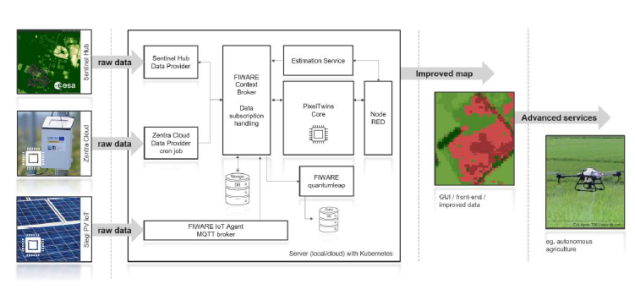Pixel Twins – Integrating the Earth’s Surface Into the Internet of Things

In recent years, advances in Internet-of-Things (IoT) makes it easy to apply sensors at distributed applications like smart farming. However, scaling to large areas is possible but cumbersome. Another possibility is to acquire earth observation (EO) data from satellites which scales easily for large areas and even global wide monitoring. However, satellite data is not available continuously for a certain place and specific data is not available in case of clouds.
The project “Pixel Twins – integrating Earth’s surface into the internet of things” divides the earth’s surface into equally sized pixels which are then linked with EO data and satellite data. These data can be combined using use-case-depending mathematical algorithms. The satellites provide area wide EO data which are combined with the timely continuous IoT data in order to calculate area wide and timely continuous estimations. This allows that even coarse-resolution EO data can be calibrated with high-accuracy local IoT data. The overall result is a significantly increased data quality which enables new fields of applications.
The approach has been applied on two different use case in the Pixel Twins project: smart farming and photovoltaics. In the smart farming use case, NDVI data from Sentinel-2 satellite is combined with local IoT-based captured NDVI data. The result is an improved and continuously available estimation of NDVI data around the IoT sensors. The photovoltaic (PV) use case presents possible improvements of estimating the energy potential at different geographical locations using IoT data sources of real PV installations. Historical EO data is used to calculate average cloud coverage which then enhanced with one-year IoT data. The result is an improved energy potential estimation around the IoT sensors. In both use cases, a web-based GUI has been implemented to support the demonstration of the implemented solution.
